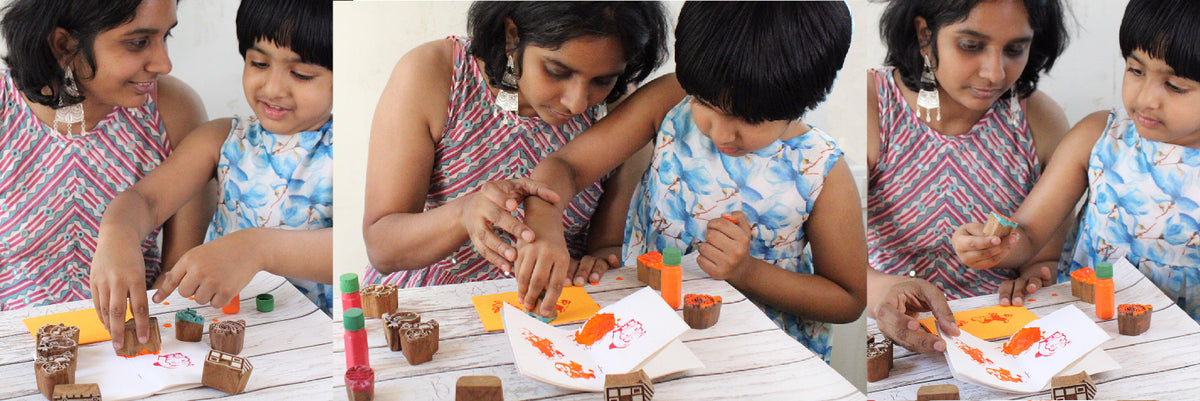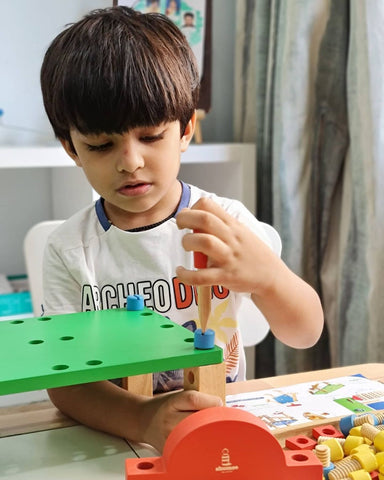If asked to list the important subjects you learnt as a child, math, science, and languages might easily come to mind. Most of us have been taught that these improve our chances of succeeding in the world, whereas art is meant to be a hobby.
Even as adults, we usually associate making art with relaxation, unwinding, or a creative outlet to enjoy for its own sake. While art is certainly meditative and fun, there’s so much more that it offers!
Researchers and art therapists say that it can improve problem solving, strengthen memory, reduce anxiety, and hone many other cognitive, emotional, and life skills.
For young children, it’s even more valuable. The International Child Art Foundation says that, “A child who is exposed to the arts acquires a special ability to think creatively, be original, discover, innovate, and create intellectual property—key attributes for individual success and social prosperity in the twenty-first century.”
So how can you provide your child with more opportunities to make art? What skills does making art hone for a toddler or a preschooler? How can you guide them to express themselves authentically? Read on to find out!
Think of art as a form of play
Have you noticed how easily your child can get lost in creation if you hand them a paper and paint or a drawing board and a marker? Making art comes intuitively to children and there’s a reason why.
Not an artsy, craftsy parent? We’ve got you covered! Listen to this podcast for easy tips to get creative with your child. |
A toddler scribbling on an easel board is focused on how to hold a pen and move their hand, the shapes they can make, and the way they combine different colours. For them, art is a way to explore basic concepts such as cause and effect and hone primary skills like motor and sensory skills. In other words, for a child, art is play!
Children learn everything about the world through simple games. When pretend playing with a kitchen set, they hone their imagination and socials skills. When throwing a ball around, they build strength and motor skills. Art is a particularly impressive form of play because it offers a great amount of learning opportunities.
All you have to do is provide your child a few basic materials and step back. Their innate curiosity and creativity will pave the way for the rest of the experience!
How do children benefit from making art?
1. Strengthens motor skills: Using a sketch pen on a drawing board, a paintbrush on paper, or rolling playdough will all hone your child’s grip and arm strength. Making art will also help develop their hand-eye coordination and bilateral coordination.
2. Sparks creativity and imagination: Art is one of the easiest ways for your child to exert their creativity! On a canvas, your child is free to explore possibilities – a purple tree, a blue giraffe, or pink skies, their imagination is the limit!
3. Develops executive functioning skills: Making visual art and playing with DIY activity toys will also hone your child’s executive functioning skills such as problem solving, visual processing, focus, and memory.
4. Allows them to practice decision making: When choosing a colour, deciding on which shape to draw, or what pieces of paper to stick together, your child has to make a decision. Creating a piece of art is filled with many such opportunities for them to practice making decisions they feel confident about.
If your child loves using paints and stamps, this fun DIY video is filled with awesome ideas for them! |
5. Hones emotional and social skills: While making art may be a solitary activity for adults, that’s far from the truth for kids! Children enjoy making things together with their siblings and friends. From a colourful handprint card for mama to a DIY dollhouse, creating is a wonderful way to foster empathy, patience, and teamwork.
6. Provides a way to self-soothe: Simply putting colours on a page or smearing paint across a surface is all it sometimes takes for a child to quiet an agitated mind and find their happy place.
7. Enables self-expression and communication: For a child who is still learning to speak, art can be useful to share what they are thinking and feeling. Even if we may not understand everything a toddler or a preschooler makes, they will feel joy and pride in expressing themselves!
5 ways to help your child play with art
1. Use simple materials
As we discussed, kids use art to learn basic concepts and master the most necessary skills. While there are many fancy art toys in today’s market, they may not always serve this purpose. The simpler the better – a paper and a crayon is a great place to start!
For slightly older children, a Kids’ Easel Board or themed Colouring Mats are perfect. These will allow them to experiment with drawing and erasing, colouring within the lines, and even building stories as they create.
2. Follow your child’s lead
In her popular Ted Talk, illustrator and journalist Wendy MacNaughton talks about how this happens – there’s a point where someone draws a circle with dots and lines inside it and tells a child that this is a face. But that’s not really how a face looks, is it? If it were up to a child, a face they draw may not look like an actual face, but it would certainly be something far more original and awesome!
Art is all about paying attention to our surroundings and recreating it in our own unique way. Children are masters at doing this, just hand them a drawing board. Instead of showing your child how to draw a house, let them create what they wish to, and you can try to imitate what they do. In this way, they won’t feel frustrated by your advanced skills but will enjoy showing you what they are exploring!
3. Make way for some mess
Children don’t think outside the box, they have no idea what the box is! This means that their impulse won’t be to use a crayon neatly on paper. They may want to scribble on the walls, use their stamps on different objects, or use playdough to stick things together.
While you may need some rules around what is and isn’t acceptable, remember that the open-ended and free flowing nature of art is what makes it so fun. This is sure to come with a little mess, so be prepared to clean up after your child is done creating. Better yet, get them to join in and turn it into a cleanup party!
Each shumee toy is made by a local artisan who spends hours perfecting their work. Click here to read about the folks behind the magic of your favourite toys. |
4. Save the talking for later
Try not to keep asking your child what they are creating as this might pressurize them to do things in a specific way to gain your approval. You can create alongside them or just stick around to help them if they ask for it. Once they are done, ask them about what they’ve made and listen carefully.
If you want to compliment your child, remember that kids know the difference between “very nice!” and “I really like how you used this green colour here”. Just like us, they love it when people notice the details of what they’ve poured their heart into, so get specific!
5. Think of the process, let go of the product!
Artists usually create to understand and express what they are thinking. The end product might even look a little bizarre, but that’s not what matters! Even with children, what they learn along the way is far more valuable than drawing a neat picture of a car or making a perfect dollhouse.
Encourage them to express themselves without needing anyone’s approval. Appreciate the effort they put into making what they did and the patience they had to create it. If all they did was scribble, then maybe they needed a space to exert some energy.
When you give your child this space to create, they will always lean into that innovative spark within them. Just make sure they are safe and enjoy watching as they discover new things and grow!



